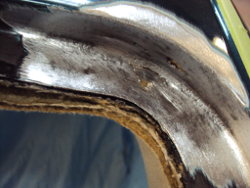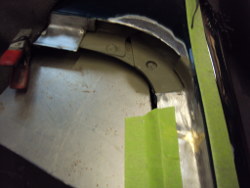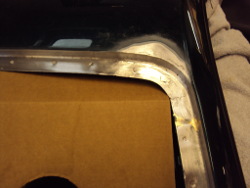Saturday, December 30, 2017
Windshield Frame Rust Repair (The Sequel)
One day last spring, just before I began the driveline overhaul project, my brother was chatting with me while I washed the car. He was standing about 10 feet away from the car when he interrupted himself, pointed at the windshield and said "did you notice the rust on the corner there?" I naturally dropped my wash mit in the bucket and promptly walked over to the windshield frame to conduct my own inspection. Sure enough, a section of paint had bubbled up once again. This irritated me to be honest. I spent a lot of money addressing rust on the windshield frame back in 2013, and it was back with a vengeance.
I would have brought the car to the body shop at that time (and in retrospect, probably should have) but I had my hands full with work and the driveline overhaul project prep so I decided to wait until the end of the project. Unfortunately the project took about twice as long as I originally planned and I did not feel comfortable releasing the vehicle to anyone until the engine was fully broken in, so I was ultimately forced to wait until the end of November to deliver the car to Caruso's.
For the first couple of weeks following delivery of the vehicle temperatures were pretty reasonable (highs in the 40s/50s) so I drove the E46 much as I did earlier this summer and all was well. That is until the shop called to let me know they needed the car longer and that very same day the forecast changed to indicate a snow storm was expected to hit a few days later. I waited until the last minute hoping the storm would fizzle out but eventually had to ask my brother to borrow his pickup. As it turned out the storm came and went without meeting the original forecast but it still dropped enough snow that I was glad I had access to another vehicle even if it was having issues (see below).
The shop wound up cutting out several small sections of metal around the window frame, including a questionable area on each A pillar that were not revealed until the windshield was removed. They fabricated new pieces to fit and tig welded them in before refinishing the vehicle. They decided to bring the entire frame down to bare metal before coating it with an epoxy primer, followed by some standard primer. The color was blended into the roof but because there were no shadow lines or other places to break the clear the entire roof had to be cleared, similar to what was done in 2013. I suppose the good news in all of this is that, for the first time in the history of this vehicle and probably eight windshield replacements, they managed to avoid cracking the windshield during the removal process so I was able to reuse the windshield, saving the considerable cost of a new part. Unfortunately, the job wound up costing as much as the work I did in 2013. Which is to say, like everything else I've done to this car lately, it wasn't cheap.
When I was informed of the extent of the work required and the reality that the drip moldings would have to be removed I told them to order new parts, as I knew all too well that these frequently and unavoidably bend upon removal. About three weeks in the shop called to tell me that the job was done but that the drip moldings had not yet arrived, though their local dealer was expecting them "in a few days". I allowed the car to stay at the shop simply because they had already placed the order for the moldings and I really did not want the job of installing them. A week later I looked up from my work long enough to become impatient so I called the shop and discovered that the local BMW dealer had pushed back the delivery of the parts. I naturally offered to contact my local dealer and the parts reps I trust to give me a straight answer. Unfortunately, that's exactly what I got. There were none of the drip moldings in the US or Germany, the manufacturer had slipped the delivery date several times already and the new delivery date (to BMW in Germany) was January 24th. That meant the earliest I was likely to see the the parts was the end of January. Needless to say, I made arrangements to pick up the car a couple days later.
Incidentally, my local parts rep told me that BMW had ordered 2000 of the moldings from the supplier and there were 700 on backorder...including mine, meaning that a lot of other people were attempting to buy these parts. I suppose that's the glimmer of hope here -- there are enough of us crazy E36 owners to make this worth BMW's time. Although the shop gave me the original moldings and one of them isn't in bad shape, the other is bent in a few areas and would look like hell if installed again so the car will remain without its roofline moldings until the new parts arrive...sometime in the spring no doubt.
Chatting with my technician after I placed the order for new moldings I learned that even common parts like door pull cables and other interior trim pieces on the latest cars are experiencing shortages, so this is not merely an issue with the age of the E36. It sounds to me like whoever is running BMW's manufacturing logistics is taking "just in time" a little too seriously.
Charging System Diagnostics
When I borrowed my brother's truck he warned me it was having issues with its charging system and experiencing slow / hard starts. While the truck was in my driveway I decided to put one of my oscilloscopes to work and test a theory. I figured the problem was a combination of a bad alternator (or more specifically, a bad rectifier, i.e. a blown diode) and a sulfated battery. Given the scope screenshot below I think my initial diagnosis was correct. The upper portion of the waveform shows normal and expected ripple but the huge periodic dropouts with an amplitude of slightly over 1 volt peak to peak are a classic sign of a failed diode (or broken winding).

I managed to charge the battery with one of my Battery Minder units and found, as one might expect, that the hard starting was far less pronounced once the battery was properly charged. But I also found that leaving the battery off the charger for about 48 hours caused its voltage to drop from roughly 12.7 (fully charged) to 12.3 (about 60%), which meant this battery was rapidly self-discharging. I assumed this was because the battery was sulfated, which in turn was likely because the alternator was not fully charging the battery due to its lower output caused by the failed diode/winding AND because this is the one of the few vehicles my brother owns that is not continuously on a battery charger.
While I had only expected to keep the truck for a few days it stayed in my driveway for nearly two weeks, so I used the opportunity to conduct a few battery experiments. Interestingly, I did find that the battery self-discharged more slowly after I completed several charge cycles with the Battery Minder and allowed the unit to remain on the battery for an extended period of time after it was fully charged, as required to give the Battery Minder's desulfation technology time to work. With the charger removed I measured the battery voltage 24 hours later and found that it had discharged to "only" 12.4 volts. Probably in the noise, statistically speaking, but a datapoint nonetheless. In the next test cycle it was near 12.5V and after the last cycle it was around 12.55V. Was this apparent reduction in self-discharge rate a result of the Battery Minder's desulfation technology? Possibly. But if I am to be honest it did not eliminate the hard starting problem or the need to replace the battery.
As I've said previously the best way to avoid sulfation is to keep a battery fully charged with an intelligent (i.e. multi-stage) charger. If you do that the desulfation technology of the Battery Minder largely becomes moot. However, I still advise the purchase of the Battery Minder over the Battery Tender for two reasons -- the ability to deliver higher charging currents as required to bring a deeply discharged battery back to full charge in a reasonable time and overall quality of the unit. All of my Battery Tenders failed within a year or two, while all my Battery Minders (the earliest of which is over four years old at this point) continue to function reliably in all temperatures.
Mileage: 270900






